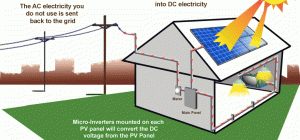 Green energy initiatives are a large part of today’s government and community strategies to help the United States become less dependent on fossil fuels. This focus means that many power companies around the country like Plymouth Rock Energy have created programs and made efforts to make their company services as green friendly as possible.
Green energy initiatives are a large part of today’s government and community strategies to help the United States become less dependent on fossil fuels. This focus means that many power companies around the country like Plymouth Rock Energy have created programs and made efforts to make their company services as green friendly as possible.
Upgrades to LEED Program Announced
One such program was recently announced by the United States Green Building Council (USGBC), representing an effort to update and improve the Leadership in Energy and Environmental Design (LEED) Green Building Program which was designed to improve facility energy performance. The USGBC has created new benchmarks for companies and individuals to achieve in the coming years, in hopes of improving the power management performance of buildings across the country.
New standards announced by the United States Green Building Council (USGBC) were presented at the annual Green Building International Conference and Expo that was held in November 2013 in Philadelphia Pennsylvania. USGBC President and CEO, Rick Fedrizzi, explained in a press release how LEED is committed to energy savings and efficiency with the creation of a totally new industry of business enterprise focused on these efforts. He explained the passion that goes behind the ambition of the green building community to have a significant impact on global and local change that will create more resource efficient and cost effective green buildings across many industries.
These new benchmarks will affect the power management of data centers, distribution centers, warehouses, existing schools, mid-rise residential projects, and existing retail buildings. LEED v4 also seeks to educate building managers in more efficient use of daily energy needs. One of the results of these new rules will mean that the base level of accreditation will now include standards for demand response capabilities. When businesses and building managers comply with these levels of efficiency and reduce energy loads during peak demand periods, they will be able to receive discounted electricity rates.
In order to receive the credits, they will need to have fully automated or semi-automated demand response standards implemented into their systems. Other credits will also be available for any company wanting to receive LEED certification, reduce costs, and improve efficiency of their power management strategies.
Steps to Create Sustainable Solutions
Since electricity is such an important part of today’s society, businesses and residential customers spend a lot of money setting up power strategies and paying for monthly services. These high costs can be addressed by improving the energy efficiency of homes and businesses through sustainable solutions such as demand response, solar energy, the use of ultrasonic flow meters, and other energy regulation efforts. These solutions can help to manage the power flow into a building in an orderly manner that creates improved power management throughout a business setup. Each energy company participates by setting up programs to offer credits, decreased rates, and other perks to businesses and homes who follow more energy efficient practices.
Energy Efficiency-One way that power companies are complying with new Leadership in Energy and Environmental Design (LEED) regulations is to help businesses and residential customers save energy and money while protecting the environment by offering free energy benchmarking services. This includes helping customers understand the best equipment improvements, changing from oil to gas, performing lighting retrofits, HVAC upgrades and other best practices for reducing energy use. This in turn helps to optimize building performance while preserving comfort levels of those using the buildings and keeping the company’s electricity spending at a minimum.
Demand Response-These programs help companies actually get paid to use less energy, especially during peak periods of electricity use. One example is a residential program that puts an energy saver device on the home’s power meter that can regulate energy use during high use times such as extremely hot days. This will change the temperature in the home only slightly, and yet the overall effect is that power is better managed overall by the energy company. Customers participating in this program receive an annual credit on their electric bill, plus their savings are increased simply by the use of less electricity when the device is active.
Large Scale Efforts in Power Efficiency
Other large-scale efforts include the Day-Ahead Demand Response Program, in which customers participate in an economic bidding program to offer load reduction into the wholesale market. Resources can also be contracted to meet NYISO supply requirements over a specified period of time. All of these efforts help customers, government, and the public at large to be more energy efficient and save money while helping preserve precious fuel resources in our environment.



![Americans Suffer after Hurricanes [Infographic]](https://lerablog.org/wp-content/plugins/wp-thumbie/timthumb.php?src=http://lerablog.org/wp-content/uploads/2015/09/clouds-1024x684.jpg&w=300&h=140&zc=1)



